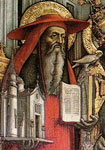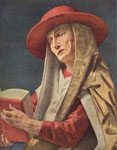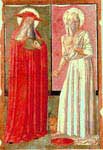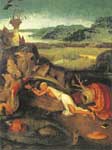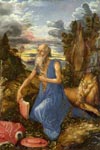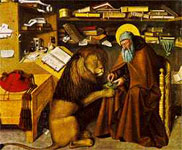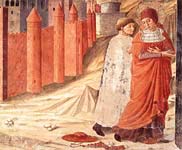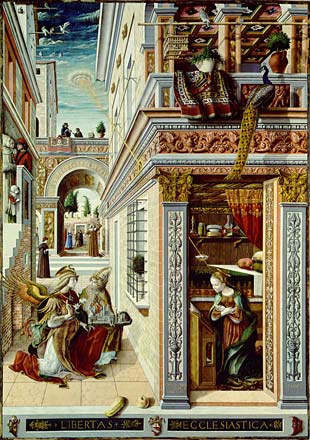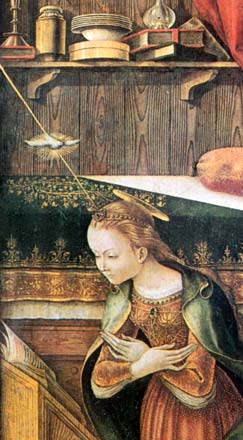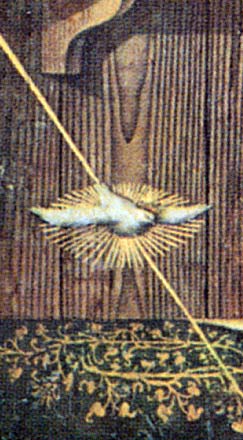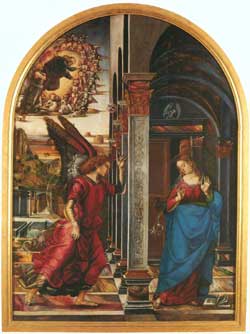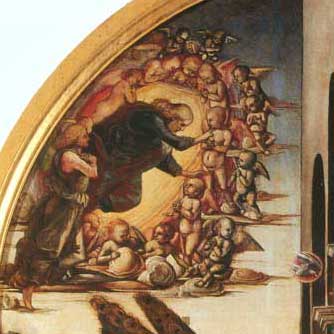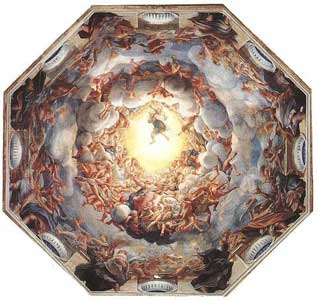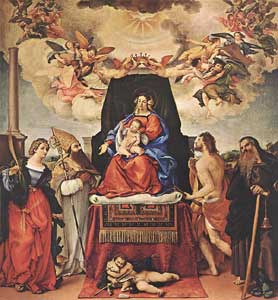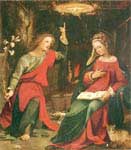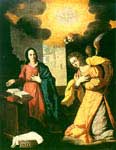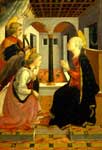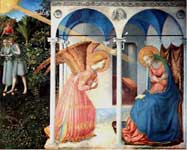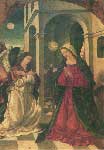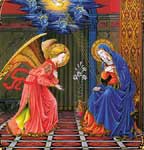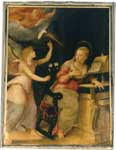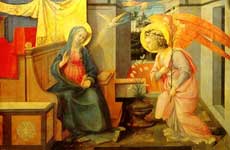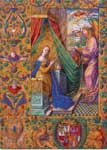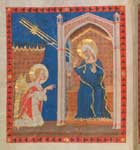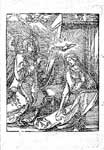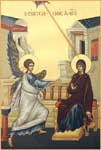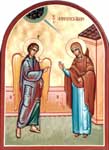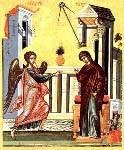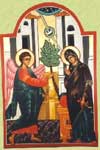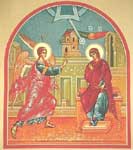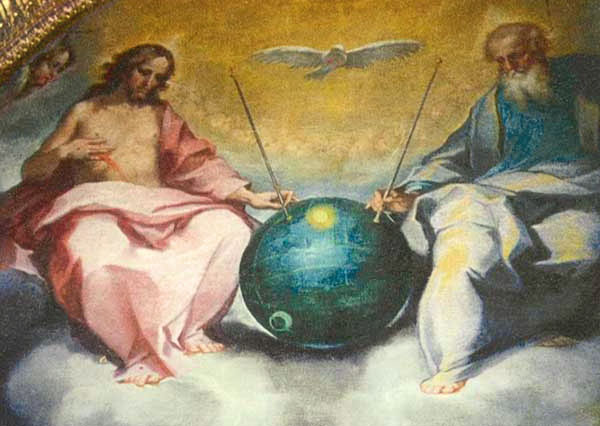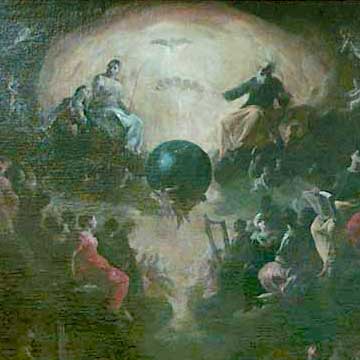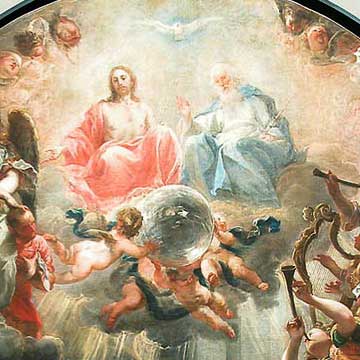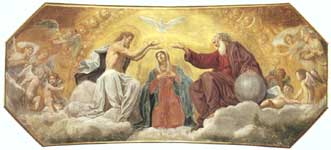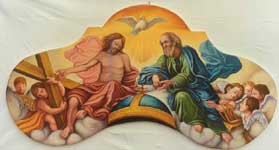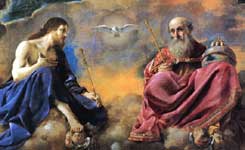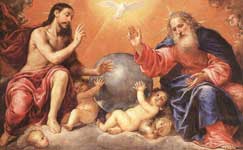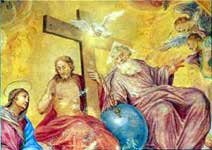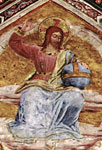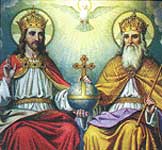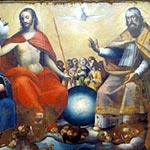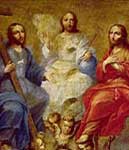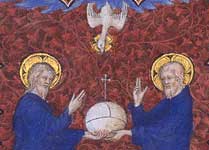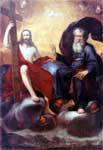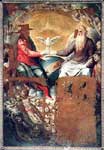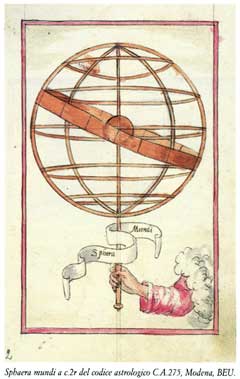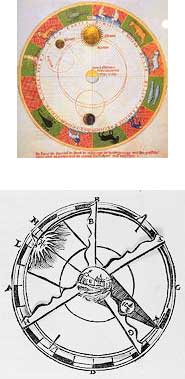Diego
Cuoghi
ART
and UFOs?
No thanks, only art...
(translation:
Daniela Cisi)
PAOLO UCCELLO, LA
TEBAIDE
(Gallerie
Dell'Accademia, Firenze)
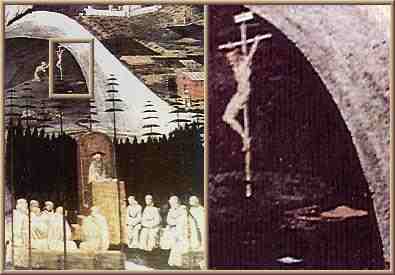
The above image, appearing in a variety of ufology web sites, is a bad reproduction of the painting entitled “Scene di vita eremitica” (NDR: “Scenes of Eremite Life”), also known as “La Tebaide”, by Paolo Uccello:
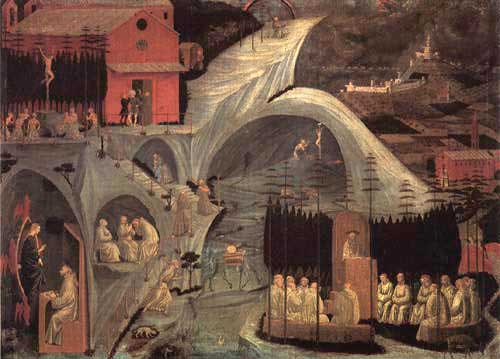
The painting represents various scenes of monastic life: at the bottom left the Virgo appears to saint Bernard; above it a group of monks flagellate themselves in front of the Crucifix; in the middle, into a large grotto, there is saint Jerome praying in front of the Cross, while at the top saint Francis kneeles down and receives the Stigmata. At the bottom right there is a representation of a saint preaching, probably saint Romuald.
According to some ufology authors, the red object appearing in the central grotto, at the right side of the Cross, is a flying saucer: «In the painting, set aside from the hill by means of a perspective effect, there is a saucer object, suspended into the air and surmounted by a red domed top. Red in color, the object comes out over the dark background by contrast. The dynamic movement of the flying object is rendered by means of light brush strokes, red in color again, which provide the effect of a sudden turn.» (NDR: excerpt from Edicolaweb, English translation by the author)
The enlargement to which the excerpt
refers to shows indeed a dark and uniform background (see image on the right).
Anyway the observation of a best reproduction clears that the “strange
object” is located inside – and not outside - the grotto, as the
kneeling figure itself. It clears as well that the object lies on the ground
close to the Cross and that its dimensions are smaller than those of the animal
close to it.
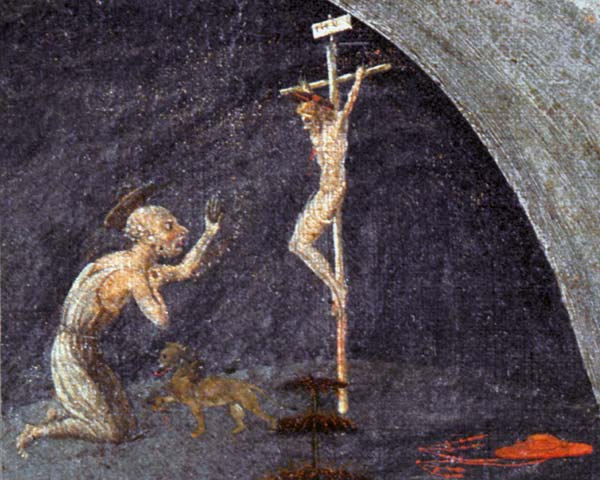

At this point anyone with a minimum knowledge in history of the arts would
recognize a cardinal hat (flaked cords are clearly visible). As a matter
of facts the kneeling figure is saint Jerome, who was told to become
an eremite after renouncing to the ecclesiastic career:
«according to one of the most common iconographical modules, Jerome
in the desert flagellate his chest with a stone while kneeling down in front
of a Crucifix or while reading the Holy Bible, in order to discover the gradual
sequence of the divine revelation and its realization in Christ. The deposition
of the purple vest symbolizes the abandon of the ecclesiastic life, full of
duties and intellectual satisfactions as well as superb vanishing glory and
the pharisaic conviction of a moral and cultural superiority.»
(http://www.cini.it/palazzocini/testi/ferrar/gero.html,
English translation by the author)
«This iconography becomes
very common between the XV and XVII century. He (saint Jerome) is represented
as an elder man with white hairs and beard, his cardinal hat close to him;
he is accompanied by the lion from which arm, according to a popular tale,
the saint extracted a thorn.” Beyond some specific moments of his life
(in the desert, flagellated by angels, while tempted or having visions, adventures
with the lion, translating, the last communion, his miracles) his figure is
represented according to three main typologies. As a penitent, dressed with
skins or poor garments, kneeled down in front of a Crucifix and beating his
chest with a stone; close to him there may be the hourglass or the skull,
symbols of the time passing by and leading to death. As an erudite, sit in
his studio in the act of writing or reading, surrounded by knowledge instruments.
As a doctor of the Church, standing still, with his red cardinal dress. Even
though the title of cardinal did not exist at that time, he is represented
like this after his work at the Pope court.»
(http://www.thanatos.it/cultura/personaggi/san_girolamo.htm,
english translation by the author)
Here is the versions of Petro Vannucci, called Perugino, and Albrecht Bouts:
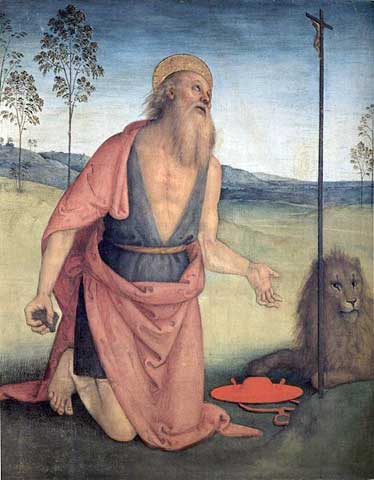
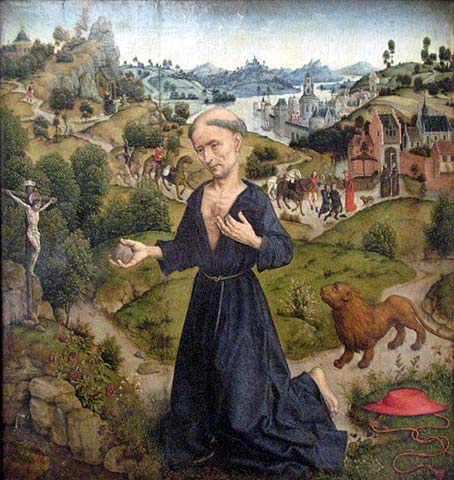
The lion close to the saint recalls the legend according to which Jerome saved and tamed the wild animal by extracting a sharp from one of its arm. In addition, the lion is the symbol of evangelist Saint Marcus and the Republic of Venice. Saint Jerome indeed was told to born in Dalmatia. In spite of this many web sites dealing with UFOs use to quote an article by Umberto Telarico published on “Notiziario UFO” n. 8 (1996) in which the animal is described as a "cagnolino" (little dog).
Hereafter is a short gallery of various paintings in which saint Jerome is represented. In the first three images he is depicted in cardinal dress, his red hat on. In the fourth image he is represented in two different ways: wearing cardinal dress on the left and wearing eremite dress on the right, the red hat thrown to the ground.
The following images then present
Saint Jerome as an eremite, praying in front of the Cross, his red hat lying
on the ground again.
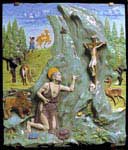
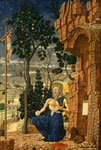


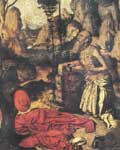


In September 1992 FMR,
the art magazine edited by Franco Maria Ricci, published two articles written
by Erika Langmuir and Erminio Caprotti about the iconography of Saint Jerome
(FMR, n. 94 - September 1992).
Quoting Caprotti: «The first biography of Saint Jerome was published
by Andrea from Bologna (around 1348), who merged together both historical
facts and legendary episodes. This author is also the one who gave to the
artists the following instructions, which became canonical, about the saint
iconography: "Cum capello, quo nun cardinals utuntur, deposito, et
leone mansueto." (NDR: “with hat, the kind used by cardinals,
not worn but set apart, and the tamed lion”) The hat at issue is the
cardinal hat present in so many representations of Saint Jerome, together
with the lion. The fact that the saint was never a cardinal, as well as never
met a wounded lion, does not matter. Once art retained these arbitrary characteristics,
they became part of the facts to be conveyed to posterity. Fortunately by
means of wonderful masterpieces.» (English translation
by the author)
Conclusions:
In the Paolo Uccello painting called "La Tebaide" there are no UFOs. The red object near the praying saint is the cardinal hat of Saint Jerome.
CARLO CRIVELLI,
Annunciazione
(National
Gallery, London)
It may be absurd but certain authors
of ufology web sites consider with astonishment the Annunciation of
Carlo
Crivelli displayed at the National
Gallery of London.
What they consider most surprising is the fact that there is a ray coming
down from the sky and reaching the Virgin Mary. They affirm that this ray
comes from a saucer-like Unidentified Flying Object standing among the clouds.
All the reproductions of the detail concerning the circle of clouds in the
sky are awful, blurred and indecipherable. No one seems to have searched for
a better reproduction. On the contrary this same version is spreading out
from one site to another again and again:
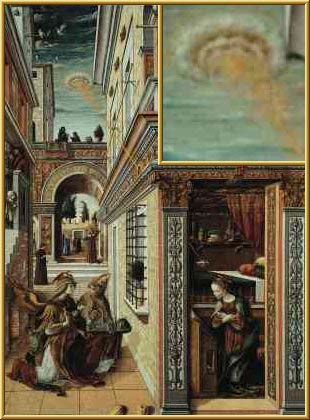
Here is the comment, in this case
quite careful, by Edicolaweb:
«Painting by Carlo Crivelli, known as “The annunciation”,
shown at the national Gallery of London. In the sky stands a big bright circle,
from which a ray of light descends, reaching the crown worn by Mary.»
(English translation by the author)
In a comment published on a different site called “The
UFOs of Crivelli”, the authors affirm that undoubtedly the object
looks like a UFO sighted in Veneto (NDR: Italian northern region) in 1999:
«What most attracts our attention is the peculiarity of the cloud
shape: indeed it appears to be quite solid, with a circular structure and
clearly different from any other cloud surrounding it. It may be either the
sun circle (direct emanation of the divine energy) or an object really seen
and thus represented by Crivelli himself. As an evidence of this latter hypothesis
stays the “thickness” of the object, which is not an abstract entity:
in addition the resemblance of the “cloud” to a UFO recently seen
in Veneto in January 1999 is clear. The reader may judge by himself.»
(English translation by the author)
Unbelievable as it may be, those who publish this stuff really seem to have never entered a museum. If so, they would notice that there is a vast amount of Annunciations in which a ray descends from the sky reaching the Madonna. Furthermore, as far as the Crivelli painting is concerned, they would notice that the object in the sky is formed by a circle of clouds inside which there are two circles of small angels.
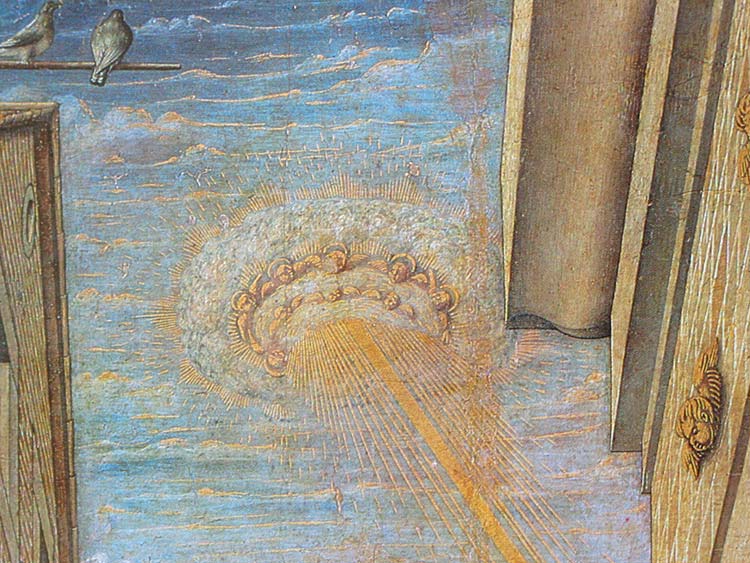
It is a very common way of representing the divinity, visible in so many works of sacred art. The same particular in an Annunciation by Luca Signorelli:
The images hereafter for example show the cupola of the Church of Parma painted by Correggio and a Madonna with Child by Lorenzo Lotto:
Gustave Doré himself, in the middle of 1800, resumed the pattern of the vortex of angels in the clouds in the following illustration of Dante's Paradise,Chant XXXI :
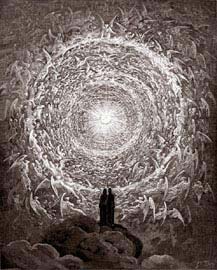
|
ma
guarda i cerchi infino al più remoto, tanto che veggi seder la regina cui questo regno è suddito e devoto». Io levai li
occhi; e come da mattina così,
quasi di valle andando a monte E come quivi
ove s'aspetta il temo così
quella pacifica oriafiamma e a quel mezzo,
con le penne sparte, |
Here are some further annunciations presenting circles of clouds, angels and rays:
Then, here is a series of Byzantine annunciations presenting rays descending from the sky, coming from an abstract form which represents the divinity:
Conclusions:
In the painting “the Annunciation” by Carlo Crivelli there are no UFOs: The ray reaching the Madonna comes from two circles of little angels inside a main circle of clouds, as in many other representations of God appearing into medieval and renaissance paintings.
"ESALTATION OF
THE EUCARISTY" (Detail of the Trinity) by Ventura Salimbeni
Church of San Pietro, Montalcino
Finally there is the controvert discussion about the so called UFO or “Sputnik” of Montalcino. This is actually the name so often used by certain sites to refer to the object represented in the church of St. Peter in Montalcino, painted at the end of XVI century by Ventura (or Bonaventura) Salimbeni. The pages of Edicolaweb for example reads: “it recalls indeed the Russian artificial satellites”. It is worth to mention that hypothesis of this kind lost strength after the publishing of the article by Samuele Ghilardi, Amos Migliavacca and Elenio Salmistraro: “The Satellite of Montalcino”.
The authors describe how the painting
has been analyzed by means of photographs taken from short distance and declare
to agree with Ion Hobana, who states: «It's very interesting the
interpretation of Ion Hobana, great expert of UFOs and author of the optimal
volume " Enigme pe cerul istoriei ". He said the object would be
an ancient map of the world, representative the Creation, in
which the sun is visible and a primitive shape of marking of the meridians
and parallels; moreover the small cylinder would be the hinge for being able
to fix to a support the sphere. An example is visible in Vatican. From the
analyses carried out on the photographies and the painting originates them
cannot be gained elements that make to suppose a ufologico event, while they
have been finds numerous points to you in common with Greek-orthodox religious
raffigurazioni. In many icons coming from from the East it is possible to
notice spheres with the same symbols and tracings, accompanied or from the
single figure of the Christ or from all the Trinity.»
Even this painting proves to be at least not so different from any other of the same gender. Indeed all paintings in which the Trinity is represented show Jesus, the Father and the Holy Spirit in the shape of a dove. Usually even the “Creation Globe” or "Celestial Sphere" is presented, symbolizing not simply the Earth but the universe as a whole. In addition many paintings present also the “wands” hold by Jesus and the Father, which are frequently described as the antennas of the sputnik. The first two are "The Adoration of the Holy Trinity" (1640) by Johann Heinrich Schonfeld and " La Messe de Fondation de l'order des Trinitaires" (1666) by Juan Carreno De Miranda. Both the paintings are displayed at the Louvre Museum, Paris.
What is considered most strange in the globe of the Montalcino painting is the detail visible at the bottom, close to Jesus feet, which many authors describe as a “periscope”. The rumen ufologiest Ion Hobana finds it similar to the central pivot used in certain globes and reports of a specific one which, according to him, could be seen in the Vatican. Despite this the detail at issue is neither a periscope nor a pivot. Clearly visible on the sphere are instead the Sun an the Moon (respectively at the top middle and at the bottom left) together with the lines which form the reverted T also present in other examples.
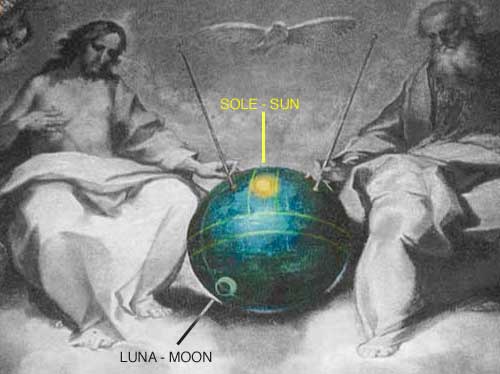
The same kind of astronomic representation into the sphere is present in another painting, by Pieter Coecke, illustrating the Trinity.
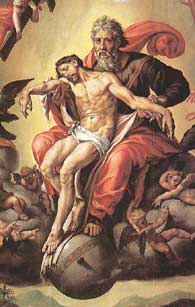
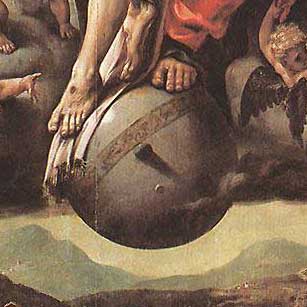
Maybe the bigger Celestial Sphere is a sculpture by Giacomo Colombo in the Trinity Church of Popoli (cm.130 x 100 x h165), and the smallest is in the hands of Jesus and Mary in a painting of Tommaso di Stefano Lunetti, where the Celestial Sphere is very similar to the one painted by Salimbeni.

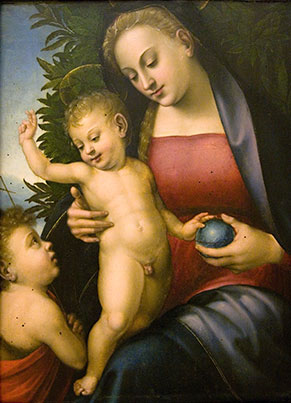
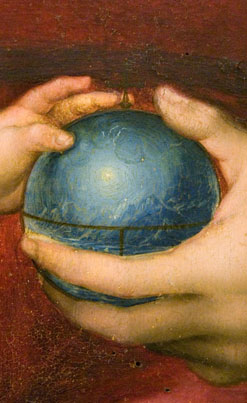
Focusing on the sphere,
anyone can see the Zodiac, the Sun, the Earth with its
shadowing cone and the Moon, very small at the bottom.
It's a representation of the Sphaera
Mundi, with the Earth at the centre of the Universe, held by God's
hand.
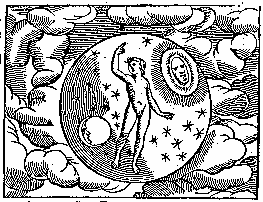 |
||
| Another representation of the Celestial Sphere in a painting by Jan Provost titled "Christian Allegory" (Paris, Louvre). | In this illustration, taken from Minerva Britanna by Henry Peacham, at the centre of the sphere we do not see the Earth but the Human Being, and around him the Sun, the Moon an the Stars. |
Conclusions
The sphere between the figures of the Holy Trinity in the "Esaltation of the Eucaristy" by Salimbeni, is not an UFO. That object, painted in many Trinity representations, is a symbol of the "Celestial Sphere", and in this particular painting contains the illustration of the Sun and the Moon.
I MISTERI DELLA MAPPA DI PIRI REIS

